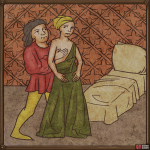Text
In Bohemia, brothels were called “hampejz”, ‘whorehouse’ or ‘house of shame’, but not ‘brothel’. Prostitutes were simply called ‘whores’.
The profession encompassed several categories. The most deprived prostitutes were homeless and provided services in the streets. Others visited their customers in their homes disguised as bread sellers, while others were ‘at hand’ at a given court. Then were those who offered their services in brothels of various price categories, whose clients were townsmen, officials and nobles (or conversely, the most vulgar clientèle, in the cheapest brothels).
Brothels were run not only by townspeople, but often by clergy (for example, the Parish Priest of the Church of St Giles under Vyšehrad). Often a brothel was directly connected to a bath-house.
During the Hussite wars many brothels were abolished, but flourished again afterwards. Legalization was aided by the Roman Catholic Church, which considered prostitution a lesser evil than adultery. It’s telling that prostitutes made up nearly 10% of the population in Papal Rome.
There were numerous regulations and laws governing brothels and the ‘oldest profession’ in general, as well as special taxes. There were even laws requiring considerate treatment of prostitutes and protecting them from violence.


No Comments